Dedicated to G. Nammalvar (Aiyya)…………
There were more than 300 of us – adivasis, dalits, shepherds, goatherds, peasants, students and activists – along the banks of the Pellipadugu Kalva celebrating food and the ways of life that produce this food. Three days (December 28-30, 2013) of deliberations, animated debates, dialogues and celebration on topics ranging from what is food sovereignty, articulating the real meaning of “the market”, the role of the State, globalisation, world trade and food to the struggles and successes of people in gaining control over our food, our seeds, our land and our water. In this post I’d like to share the experience more through pictures rather than words (a departure from the usual style of this blog)!
The landscape that hosted the Summit……hills and forests encircled the meadow where the celebrations, dialogues and debates were held with the Pellipadugu Kalwa providing us water.

Korra (Foxtail millet) being handpounded for breakfast on the first day….


Planning in progress….tasks being assigned to the team! Toranas being tied….
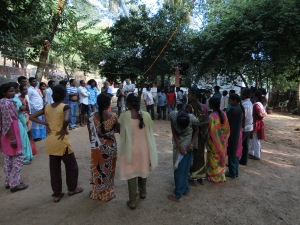
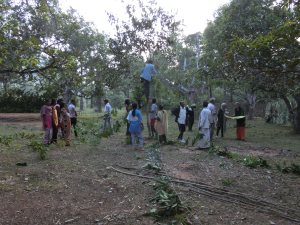
Dialogue spaces, sleeping quarters, toilets everything being built with local material and local skills……no plastic, no cement, no brick! Handpainted murals on canvas flanked the stage set up for panel discussions. The stage was made with compacted mud and held together with bamboo….
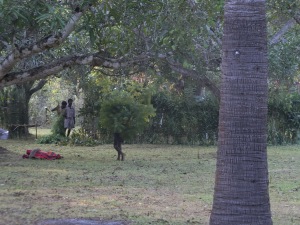

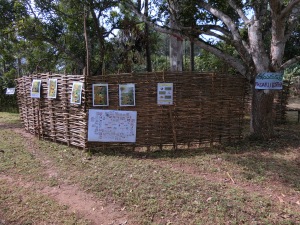

We prayed to Bhutalli to bless and protect us…..with offerings of seeds brought from various corners of Telengana and Andhra Pradesh. The offerings were celebrated with song and dance…
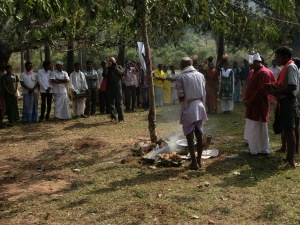

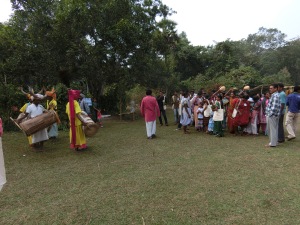
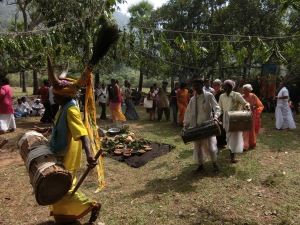
We talked ……..in large groups and small groups, through plenary sessions and in dialogue areas, over food, in the mornings, late into the night deliberating on the meaning of food sovereignty, our definitions of markets, our expectations of the State, our expectations of ourselves as individuals and as a collective, about trade and the WTO, about seed sovereignty……..we shared stories of our struggles and experiences, successes and setbacks….learning from each other and strengthening the alliance, that was emerging, to gain control of our food.
The threats to our food system, the struggles to overcome these threats and the spirit of freedom were captured in a street play Bhutalli. We did not just watch the play under the stars but were a part of it…were provoked by it and responded in spirit and action.




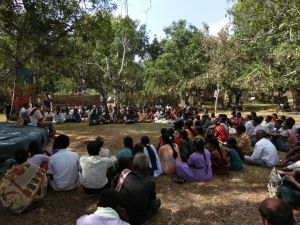 all this happening around the tree where offerings had been made to Bhutalli.
all this happening around the tree where offerings had been made to Bhutalli.
We exchanged seeds and what a diversity there was of grain, pulses, vegetables from over nine districts…..

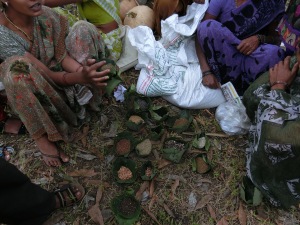

We celebrated the diversity of seeds and the diversity of food…..korra upma, ragi ambili, jonna annam, fresh fish from the Godavari, ragi sankati, mutton curry, pumpkin sambar all cooked on site by our farmer and adivasi friends from the various districts….. traditional sweets and steamed tubers were served with tea as we continued our discussions. No paper and no plastic….leafy plates that when disposed would become part of the landscape…..

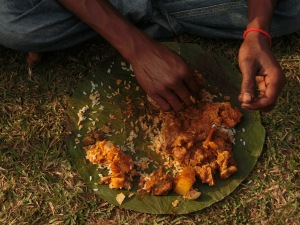
At the end of the deliberations and the celebration we put forth a declaration…..the Pellipadugu Declaration on Food Sovereignty – a new alliance was born. A draft prepared in Telugu and English was read out and comments, edits invited….it was then finalised and signed by all of us with the resolution to take it forward through action – individually and collectively!
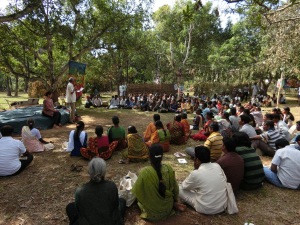
The people who hosted us …….the Girijan Deepika team at D. Bhimvaram in Addatheegala Mandal, East Godavari District and the young volunteers who made it all seem effortless!


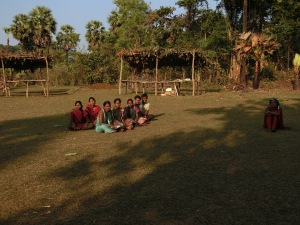
We bid our goodbyes while resolving to take the Declaration forward and empower ourselves with the sovereign right to our food! Till we meet next year…..
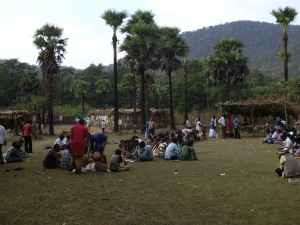

Nammalvar (aiyya) who was there at the first Food Sovereignty Summit in 2009 could not be with us this year but we know he was with us in spirit as we drafted and signed the declaration on December 30, 2013. He passed away on that same day fighting against the destruction of groundwater in Thanjavur District…..
The Pellipadugu Declaration on Food Sovereignty
We the adivasi, dalit, pastoralist, peasant, scientist and student communities have gathered here from Telangana and Andhra Pradesh, between 28th and 30th December 2013, in D. Bhimavaram village of the adivasi territories, with the collective concern to defend our sovereign right to food and the rights of mother earth.
We deliberated on the fundamental questions that concern our food: the plunder of our resources; the threats to seed sovereignty; the health of our soils; the commodification of our biodiversity, knowledge and cultures; and the destruction of our local markets by the Global Corporate industrial food complex.
For us, food is the abundance of life that mother earth provides: the diversity of grains, pulses, oil seeds, tubers, fruits, vegetables, animals, insects, fish; and the associated food cultures celebrated in our various communities. Ownership and control of land is central to our struggle for food. Markets are networks of relationships to protect, sustain and nurture our food through local reciprocal systems of exchange. They are not spaces to extract profit.
Women are leaders in the Food Sovereignty Movement. It is women who are at the frontlines of struggles for Food justice; and challenging patriarchy is an integral part of restoring Food Sovereignty.
We reaffirm the power in our peasant food webs to feed ourselves and to resist the corporate capture of our lives.
We declare that our lands, forests, water, air, diversity, seeds, knowledge and cultures are not for sale. We will resist the monetization of our lives and resources.
We assert that food security can only be met through Food Sovereignty.
We call upon the State with the following demands:
We demand that the State implement without further delay, the recognition of individual rights and community forest rights according to customary boundaries of adivasi and other traditional forest dweller communities.
We demand that the State uphold the supreme powers of the gram sabha under the Panchayat Raj (Extension to Scheduled Areas) Act, 1996 and the Forest Rights Act, 2006.
We demand that the State commit its resources to our autonomous local systems of production, procurement and distribution to ensure food security.
We condemn the State-Corporate nexus that has decimated our farming systems: including seeds, agronomic practices, dairy, poultry and fisheries.
We further condemn the State’s continued aggressive promotion of national and multinational Corporates to take over the last bastions of autonomous farming: adivasi food cultures and pastoralist livelihoods.
We condemn the decision of Government of India to ratify the “Peace Clause” at the Bali round of the WTO negotiations, that trades away our sovereign right to define our food systems.
We call for a moratorium on all ‘Free Trade Agreements’ that destroy our lives and livelihoods.
We oppose the entry of Foreign Direct Investment (FDI) in Food and Retail.
We strongly condemn State efforts to promote genetically modified crops and call for a moratorium on all field trials in accordance with the recommendations of the Technical Expert Committee on GMOs, appointed by the Supreme Court of India.
We oppose the global patent regime that privatises and commodifies our knowledge and biodiversity.
We denounce the false market solutions to climate change, and declare that Food Sovereignty is the only way to build resilience and in fact combat the Global Food Industrial System as a primary driver of climate change.
We call for the roll back of destructive State programs such as INSIMP, which in the name of promoting millets, threatens local biodiverse and autonomous agro-ecosystems.
We demand a halt to all monoculture plantations in our fields and forests.
We commit to the following actions:
We shall continue to defend our rights over our lands, forests, water and air.
We commit to deepening our relationships and traditions of reciprocity and collectivism as a means of solidarity with one another. This solidarity is the basis to resist the violence of the corporate food industry.
We shall build power through democratic local systems of governance to further food sovereignty.
We will use the power of our vote to raise Food Sovereignty as a political issue.
We shall shift from growing commodity monocultures to cultivating diverse food crops, through ecological and organic farming practices.
We shall save and exchange our seeds and thereby resist the corporate seed markets.
There is an interdependency between animals, crops, forests, water and other resources of the commons that has been broken by the industrialization of our food systems. We shall restore these broken links by rebuilding our indigenous animal resources, which in turn nourish and are nourished by these commons.
We shall reestablish local markets as a means to exchange our produce with one another, and to feed and support local communities.
We celebrate the spirit and commitment of young people in the food sovereignty movement.
We shall conscientiously nurture intergenerational spaces within our movements for sharing knowledge and practices for the future.
We hereby come together as a Food Sovereignty alliance between our movements, which shall advance this shared vision.
December 30th 2013
Pellipadugu Kalwa, D. Bhimavaram village, Addateegala Mandal, East Godavari , AP
V. Murugamma and V.Krishnamma, Dalit Mahila Sangham, Chittoor
K. Pandu Dora, National Convenor, Adivasi Aikya Vedika
M. Shivaprasad, Convenor- Telangana, Adivasi Aikya Vedika, Adilabad
K. Krishnarao, Convenor- Northern Andhra , Adivasi Aikya Vedika , Vishakapatnam
M. Kamala, G. Satyam and P Dharmu , Adivasi Chaitanya Sangham, Adilabad
Hussain Swamy, C.H Malikaarjun and Nandeswari, Chenchu Rakshana Samiti, Mahabubnagar
M. Rambabu, E. Jyoti and M. Satyavati , Koitur Kutuva Sangham, Khammam
K. Veeraswamy and C.H Durga, Adivasi Seva Sangham, West Godavari
K. Venkatesh Dora, Venkatlaxmi and K. Satyavati, Girijana Deepika, East Godavari
P. Somalingam and K. Pandamma, Jeevam, Vishakapatnam
V. Jogiraju, Derala Girijana Chaitanya Sangham, Vishakapatnam
P. Thammaiah and , Manya Deepika, Vizianagaram
S. Jayprakash, Syuryakanti Yuvajana Sangham, Vizianagaram
S. Vykuntarao and K. Prabhavathi, Savara Sangham, Srikakulam
N. Adinarayana, Sri Gopi Rytu Sangham, Chittoor
S. Apparao and K. Narayanamma, Chinna Sanna Karu Vyavasaidarula Sangham, Vishakapatnam
N. Satyamma and N. Pochamma, Ottavapantala Mahila Vedika, Medak
G. Yadigiri and Kavita, Deccani Gorrela-Mekala Pempakadarula Sangham, Medak
N. Deviah, Grama Sangham, Warangal
Prof K.R. Chowdry, Hyderabad
Dr Radha Gopalan, Chittoor
Dr Sagari R Ramdas, Hyderabad
Madhusudhan, Hyderabad
Charanya R., Hyderabad
Shruti Thrayil, Pune
M. Deepu, Hyderabad
Rahul Ramakrishna, Hyderabad
Srikrupa, Hyderabad
N. Bhavana, Hyderabad
E. Jayant, Bangalore
Aditi Pinto, Mumbai
Sandeep K Singh, Bangalore
Sharib Ali, Kolkata
Amol, Mumbai
Siddharth, Mumbai
Alia Farouqui, Mumbai





























